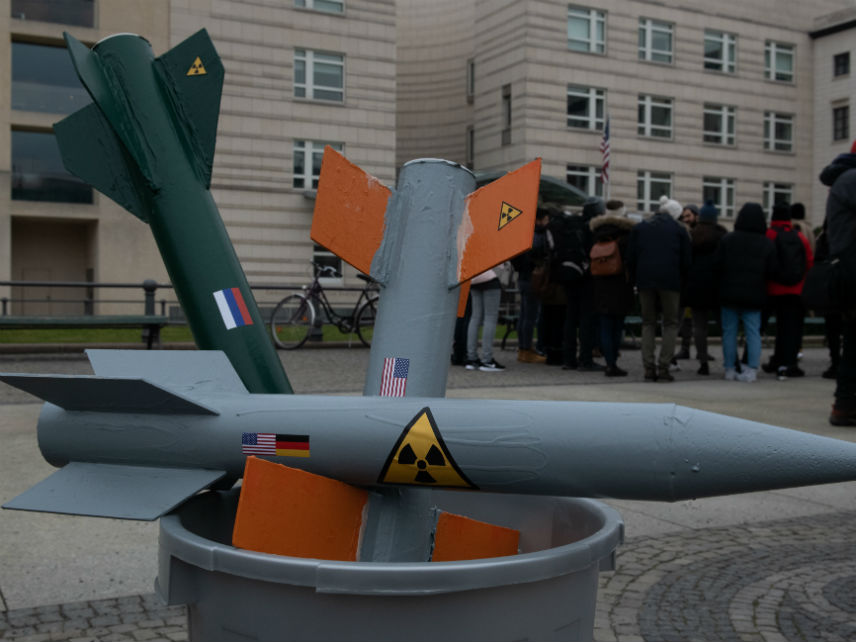The U.S. Needs New Nukes? Really?
Trump adds "tactical" weapons to America's arsenal.

Last week, Sen. Elizabeth Warren (D–Mass.) and Rep. Adam Smith (D–Wash.) introduced the No First Use Act, designed to prevent the U.S. from using nuclear weapons in a first strike without congressional approval. What should be the lowest possible standard of sanity—that the Oval Office shouldn't be able to drop the big one without any oversight—has been introduced before, but it didn't make progress.
Rep. Ted Lieu (D–Calif.), whose similar Restricting First Use of Nuclear Weapons Act of 2017 stagnated, but was re-introduced last week as well, makes no secret of the fact that Donald Trump makes him particularly nervous here, but the broader idea of not letting any president have the uncontested power to start global thermonuclear war is something libertarians and Ted should share.
The Federation of American Scientists suggests that the United States has about 6,500 nuclear weapons and Russia has around 6,800. Will Saetren, a specialist in nuclear security at the public-private nonprofit CRDF Global, suggests the American number is closer to 9,000. Whatever the correct number is, it's slated to increase: The Trump administration is putting a new weapon into production. The new project, dubbed the W76-2, marks a reversal of the last 40 years of concerted removal, control, and destruction of nuclear weapons since the U.S. arsenal peaked with about 31,000 nukes in the late 1960s.
According to NPR, the W76-2 is a 5- to 7-kiloton version of the W76-1, an approximately 100-kiloton weapon. It's a low-yield weapon, but it's still a nuclear weapon, and the use of terms like "low-yield" and "tactical" obfuscate the reality that it's still a nuke, and that once one weapon is used, others will follow. In his Doomsday Machine: Confessions of a Nuclear War Planner, Daniel Ellsberg recalls learning during the Eisenhower years that there was no U.S. plan to attack only the USSR: China was part of the deal by default, as if leveling just one country was too subtle. Furthermore, as Ellsberg told Reason, governments hate to rule anything out, no matter how apocalyptic. "I don't think any president has ever said to the Joint Chiefs of Staff, 'Nuclear first use by me, by the US, is off the table'….so that's never been our policy." Today's precise plans for nuclear war are secret, thought reportedly quite loose, but the world contains a suicidal level of these weapons. Gambling on a new low yield arms race staying contained is a bizarre risk to t take.
Why the W76-2? The main argument for it is that Russia is doing it so we have to too, to keep up and therefore prevent actual use. The 2018 Nuclear Posture Review reports that Russia has embraced "tactical" nukes in order to ward off NATO. The U.S. will respond in kind by putting the W76-2 on submarines, starting in October.
The latter prospect horrifies Saetren, who notes that once a nuclear sub fires a missile, even a smaller one, its stealth is now gone and any further payload is endangered.
Technology is flawed, Saetren notes, and one "problem with nuclear weapons is that it has to be perfect." And they aren't perfect; accidents happen. In 1961, a B-52 carrying two hydrogen bombs broke up over Goldsboro, North Carolina. One bomb's chute deployed, and on the other four of the five safety mechanisms shorted out—"and the one that worked," Saetren says, "was the technical equivalent of a light switch." Another near-miss followed only months later.
It's just "dumb luck and statistics," he concludes, that have kept the world from turning into a revival movie house showing of Threads. Well, that and men like Vasili Arkhipov and Stanislav Petrov, who refused to authorize nuclear strikes in the face of what appeared to be (and in the former case was) a real threat.
Donald Trump's fans and foes both tend to think of him as a radical break with the past, but there are important ways that he's like every other president of the last few decades. One is that no matter how much he occasionally says he wouldn't want to use nukes, he's determined to preserve his privilege to use them without restriction.
In other ways, he's now going backwards. Casually placing small nukes on submarines does nothing but create more chances for a deadly accident—or a choice that cannot be taken back.
